For small businesses, solid conflict resolution skills can turn potential disputes into stronger team and client relationships.
Resolving conflicts effectively helps protect your revenue and builds trust, giving your business a long-term advantage.
In this article, you’ll learn the essential conflict-resolving skills SMB leaders need and conflict resolution strategies for common business scenarios. You’ll also discover actionable systems and processes to stop conflict before it happens.
Key takeaways from conflict resolution skills
For SMBs, conflict resolution skills protect client relationships and revenue by preventing minor issues from spiraling into costly disputes.
Active listening, emotional intelligence, clear communication and mediation skills form the foundation of effective conflict resolution.
Processes like client check-ins and team retrospectives reduce the risk of recurring disputes.
Pipedrive helps you monitor customer relationships and build conflict-resistant systems into your workflows – try it free for 14 days.
1. Active listening to defuse tension
Active listening means listening to understand, not just reply.
When you listen, you give your full attention to what someone says. This skill stops conflicts from escalating between team members or with customers.
Active listening slows the conversation down, ensuring all parties feel heard and understood.
Here are some active listening skills with responses you can tailor to your situation:
Paraphrase what you heard. “So you’re saying the project timeline feels unrealistic because…”.
Ask clarifying questions. “Help me understand what you mean by ‘unfair workload’”.
Reflect emotions back. “You sound frustrated about the lack of communication”.
Summarize key points before responding. “Let me make sure I’ve got this right…”.
Be aware of your nonverbal communication. Wait three seconds before you respond and maintain eye contact when you do.
Practice this soft skill and you’ll find that you’re naturally less inclined to jump to conclusions. You’ll also save time by addressing the real issue from the start.
Example: A guest approaches the front-desk hotel staff, frustrated that their room isn’t ready.
The receptionist listens closely. They acknowledge the guest’s feelings: “I understand this is inconvenient and appreciate your patience”.
They ask clarifying questions: “Would you like to wait in the lounge or have us call you when your room is ready?”.
Active listening makes the guest feel heard while the front desk staff resolves the issue efficiently.
2. Emotional intelligence to understand what’s driving conflict
Emotional intelligence means recognizing and managing emotions (both yours and others’) during tense situations.
Strong emotional intelligence stops you from worsening team or customer conflicts through reactive, empathic responses. When you understand what’s driving emotions, you address the real problem instead of just the surface tension.
Here are key emotional intelligence skills and response techniques to consider:
Notice your body language and facial expressions. Tight shoulders or a furrowed brow signal rising stress. Use these signs as a cue to pause before you react.
Name emotions out loud. “I can see this situation is really frustrating for both of us”.
Take a pause when you feel triggered. “Let me think about this for a moment” buys you time to respond thoughtfully.
Match your tone to the situation. Use a calm, steady voice, even if others raise theirs.
Acknowledge others’ feelings before offering solutions. “I understand you’re worried about the deadline”.
Emotional intelligence helps you focus on solving team and customer problems instead of winning arguments.
Example: A prospective buyer reacts angrily after their offer on a property is refused.
Instead of matching the client’s frustration, the real estate agent replies calmly: “I understand this is disappointing”.
They give the client space to vent, then offer a solution: “Let’s look at similar properties that could work for you”.
By staying aware of their own emotions and acknowledging the client’s, the agent keeps the relationship manageable and on track.
3. Negotiation and problem-solving to find win-win solutions
Negotiation and problem-solving involve finding win-win solutions for both parties, where everyone gets something they need.
Smart sales negotiation protects both current deals and future sales opportunities. When you focus on mutual benefit instead of winning, you build a level of trust that leads to better partnerships and greater customer loyalty.
Prevent failure with your guide to handling tricky sales situations
Here are some examples of conflict management skills for successful negotiations between team members or customers:
Identify shared goals first. “We both want this project to succeed and stay profitable”.
Offer multiple choices. “We could extend the deadline, add resources or adjust the scope. What works best for you?”.
Be firm on priorities but flexible on methods. Protect the non-negotiables, like quality assurance, while exploring creative ways to meet deadlines or sales budgets.
Acknowledge trade-offs openly. “If we rush this, we might compromise quality, but if we delay, you’ll miss your launch window”.
Focus on future value, not past mistakes. “How can we prevent this issue on the next project?”.
Master this balance between assertiveness and flexibility, and you’ll not only de-escalate conflict but shorten your sales cycle.
Example: A customer calls his banking services provider, upset that he incurred incorrect fees for a wire transfer.
Two customer support agents blame each other for the mistake. One says the other should have checked approvals, while the other says the first misentered the details.
The team lead steps in and focuses on the shared goal: fixing the client’s issue quickly and correctly.
They suggest a plan: one agent corrects the transfer and fees, while the other contacts the client to explain what happened and apologize.
By dividing tasks based on speed and expertise, both agents feel involved in the client’s complaint resolution.
4. Clear communication to set expectations early on
Clear communication means expressing your needs and boundaries in ways customers or team members can easily understand and accept.
Effective communication prevents workplace conflict before it starts. When team members know exactly what’s expected and why, confusion and resentment don’t have room to grow.
Clear communication with customers also builds trust and prevents disputes. Stating expectations around timelines or deliverables up front reduces the chance of frustration later on.
Here’s how you can communicate to reduce and resolve conflicts:
Use “I” statements to express concerns. “I need the reports by Tuesday to meet our client deadline”. Not “You always submit things late”.
State boundaries with business reasons. “We can’t extend credit beyond 60 days because it affects our cash flow”. Not just “That’s our policy”.
Be specific about expectations. “Please update the project status every Friday by 3 PM” beats “Keep me informed”.
Choose neutral language over charged words. Say a project is “behind schedule”. Not that it’s “a disaster”.
Acknowledge different perspectives before presenting your point of view. “I understand you’re focused on quality, and we also need to consider the deadline”.
Strong communication skills help you create a work environment where issues get resolved through understanding rather than arguments.
Example: A client asks her travel agent for a last-minute hotel room upgrade.
The travel agent communicates clearly: “I can ask, but there’s a chance the hotel may be fully booked. If the room type you want isn’t available, you can stick with your current booking or I can look for similar accommodation at a nearby hotel”.
By using clear language and showing proactive customer service skills, the agent prevents misunderstandings while keeping the client happy.
5. Mediation and facilitation to find common ground
Mediation and facilitation means guiding conflicting parties toward solutions with an open mind and without taking sides.
Strong mediation skills turn you into a valuable asset when workplace conflict arises between team members or with customers.
Instead of letting disputes damage relationships and productivity, you become the person who helps involved parties find common ground. Here’s how:
Set ground rules at the start. “We’ll each speak for two minutes without interruption, then discuss solutions”.
Ask open-ended questions that reveal shared interests. “What outcome would make this project successful for both departments?”.
Redirect blame toward problem-solving. “Let’s focus on preventing this issue next time rather than what went wrong”.
Summarize each person’s perspective before moving forward. “Sarah needs faster approvals, Mike needs quality control, but both ultimately want to delight the customer”.
Stay neutral with your language. Use “the situation” instead of “your problem” or “their mistake”.
Developing dispute resolution skills is useful for anyone, and learning how to apply them in real-life work scenarios will help you feel confident when team or customer disputes arise.
How to apply conflict resolution skills to common business scenarios
Conflict situations aren’t just unpleasant. They can derail sales activity and impact your team’s well-being.
Be prepared for everyday causes of conflict with the following tips to stop them from hurting your business.
When service delivery goes wrong
Service delivery failures, like a broken feature or delayed shipment, put customer connections and sales revenue at immediate risk.
Own up to the impact on your customer’s business right away with an apology email. Here’s a good example from Zocdoc:
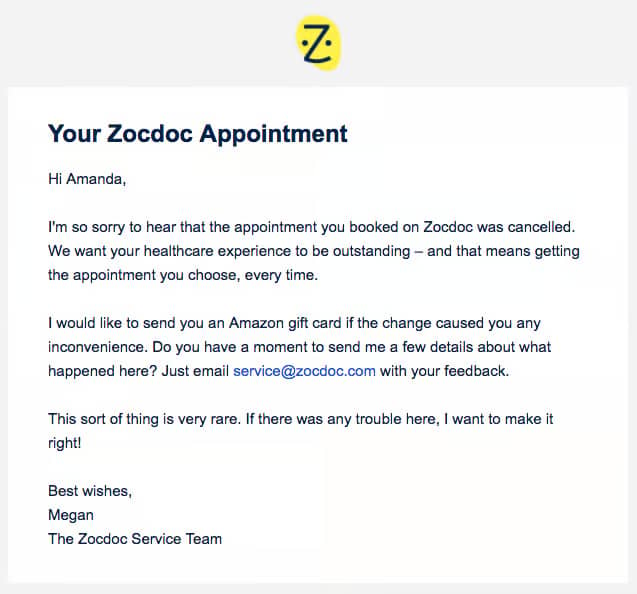
Next, create a plan with specific steps and deadlines so customers know exactly how you’re fixing things.
Offer a discount or account credits to say sorry. It’s a small gesture that shows you care about customer relations.
Send a follow-up email within 24 hours that spells out what happens next. Good follow-through shows accountability and often makes relationships stronger than if nothing had gone wrong.
Example: A SaaS company’s API (a connection between software programs) crashes for six hours.
A customer success manager calls affected clients right away to own the problem. She sends hourly updates about the fix and offers one free month of service to show customer appreciation.
The next day, she sends an email explaining how the company plans to prevent future breakdowns by conducting regular checks and adding a backup system.
Navigating pricing and scope disputes
Pricing and scope disputes can kill deals and damage client relationships if you handle them poorly.
When clients ask for extra work don’t just say no, as that can make them feel dismissed. Instead, explain how the new request affects timeline, quality or other priorities they care about.
Find middle-ground solutions that work for both sides. You might offer a basic version now and the full version later. Or even let them choose features to cut to make room for new ones.
Reset expectations early when budgets get tight. It helps to use language that connects costs to business goals. Instead of “This costs $5,000”, try “This feature will save your team 10 hours per week, which pays for itself in two months”.
Example: A marketing agency’s client wants to add social media management to their existing SEO contract without increasing the budget.
Instead of refusing outright, the account manager explains that adding social media would mean less time for SEO lead generation.
He offers three options: increase the budget by 30%, focus on two social platforms instead of five or wait until next quarter when the team can plan properly.
Resolving team conflicts that impact customers
Workplace conflict between team members can cause a lack of professionalism that hurts your company’s reputation and potential deals.
Address any tension fast before customers notice. Get both sides to explain their point of view. Focus on finding common ground around shared work goals, like customer satisfaction, then figure out how to deliver it together.
Stay neutral when conflict situations come up by focusing on the work impact, not who’s right or wrong. Ask questions like “How does this affect our client deliverables?” instead of taking sides.
Example: A software company’s sales rep promises a custom feature the development team says is impossible to build in time.
Instead of discussing the issue directly with the customer, the project manager acts as a neutral third party and brings both sides together privately. They ask what the client really needs and discover it’s better reporting.
The team finds an existing feature that solves the problem, keeping both the sales rep and the developers happy while delivering what the customer wanted all along.
Managing vendor and supplier disputes
Supplier problems can hurt your customer relationships (even when the mistake isn’t yours), as you’re ultimately responsible for the outcome.
Fix today’s problem for your customer. Sometimes, that means adjusting timelines. Other times, it’s about finding alternative suppliers. Occasionally, it requires eating into extra costs to keep everyone happy.
Know when to escalate issues and when to handle conflict management yourself. Let go of minor issues with good vendors.
Repeated failures need higher-level conversations about the relationship. When the conversation happens, approach the dispute as a shared problem to solve together rather than as a blame game.
Example: A marketing agency’s printing vendor delivers incorrect brochures two days before a client’s big trade show.
The account manager arranges rush printing with a backup supplier at double the cost.
She calls the original vendor to discuss how to improve delivery, maintaining the relationship while ensuring her client’s show goes to plan.
While knowing how to resolve common disputes is crucial, building systems that stop them from arising is even more powerful.
How to build a conflict-resistant business
The most effective conflict resolution strategies focus on preventing problems before they appear.
Here are three practical strategies for building prevention into your sales and customer success workflows.
1. Spot trouble early (and keep note of it)
Early warning signs help you address issues while they’re still small and fixable.
Most causes of conflict start as minor communication breakdowns or unmet expectations that grow over time.
Here are some warning signs to track for successful conflict mitigation:
Team warning signs | Customer warning signs |
Changes in response time or communication style | Changes in response time or communication style |
Shifts in eye contact, facial expressions or tone during video calls | Clients copy additional people on routine communications |
Team members miss deadlines or avoid collaboration | Increased complaints about workload or project scope |
Team members show decreased engagement in meetings | Escalating tone or frustration in emails or calls |
Frequent miscommunication among team members | Requests for repeated clarification or missed expectations |
A customer relationship management (CRM) platform like Pipedrive helps you track potential issues with employees you engage with and people you do business with.
Add a note to customer profiles whenever you notice changes in client communication or unusual behavior patterns. This oversight will help you keep your team aligned and proactive.
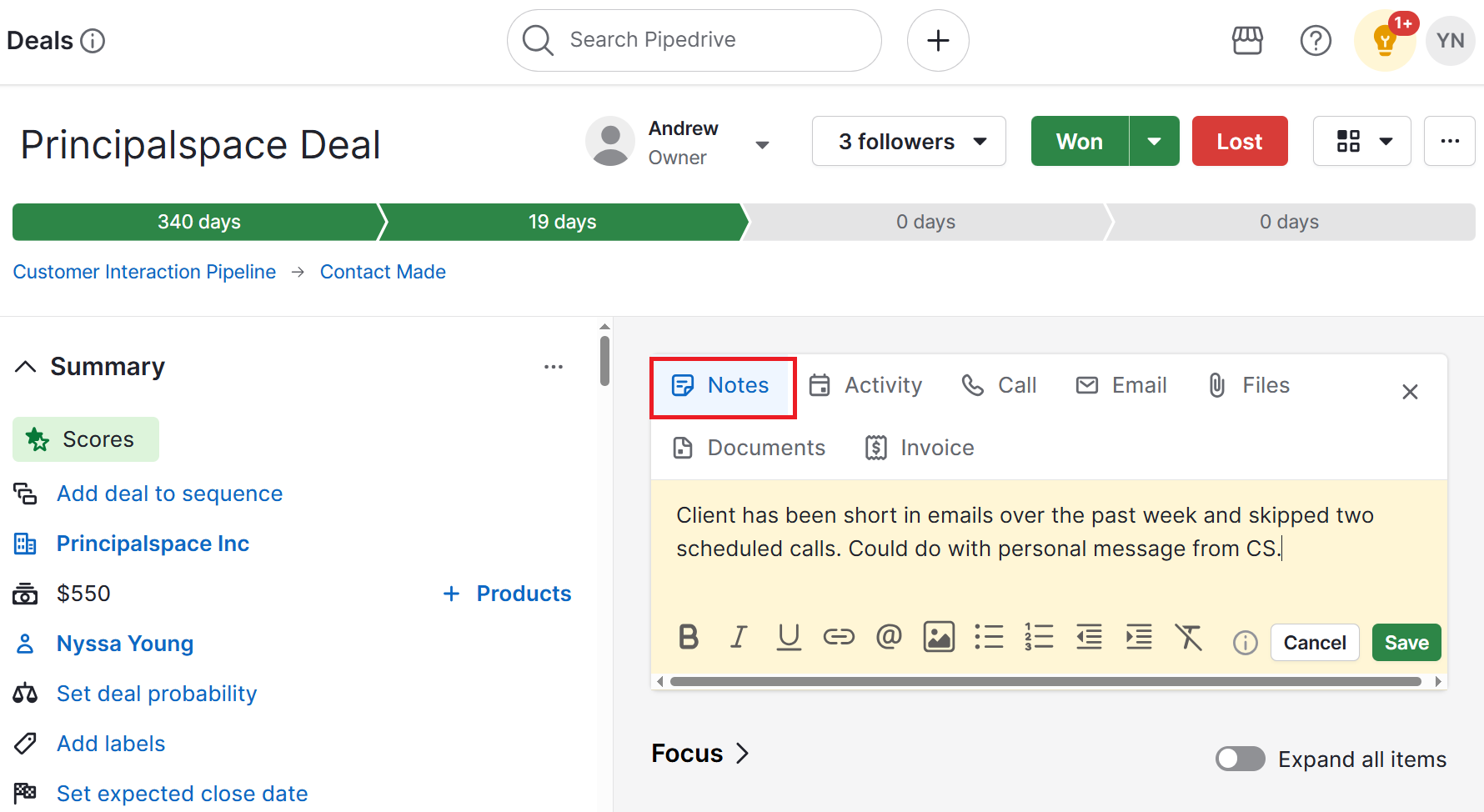
Create custom labels like “relationship risk” or “follow-up needed” to flag customer accounts that need extra attention.
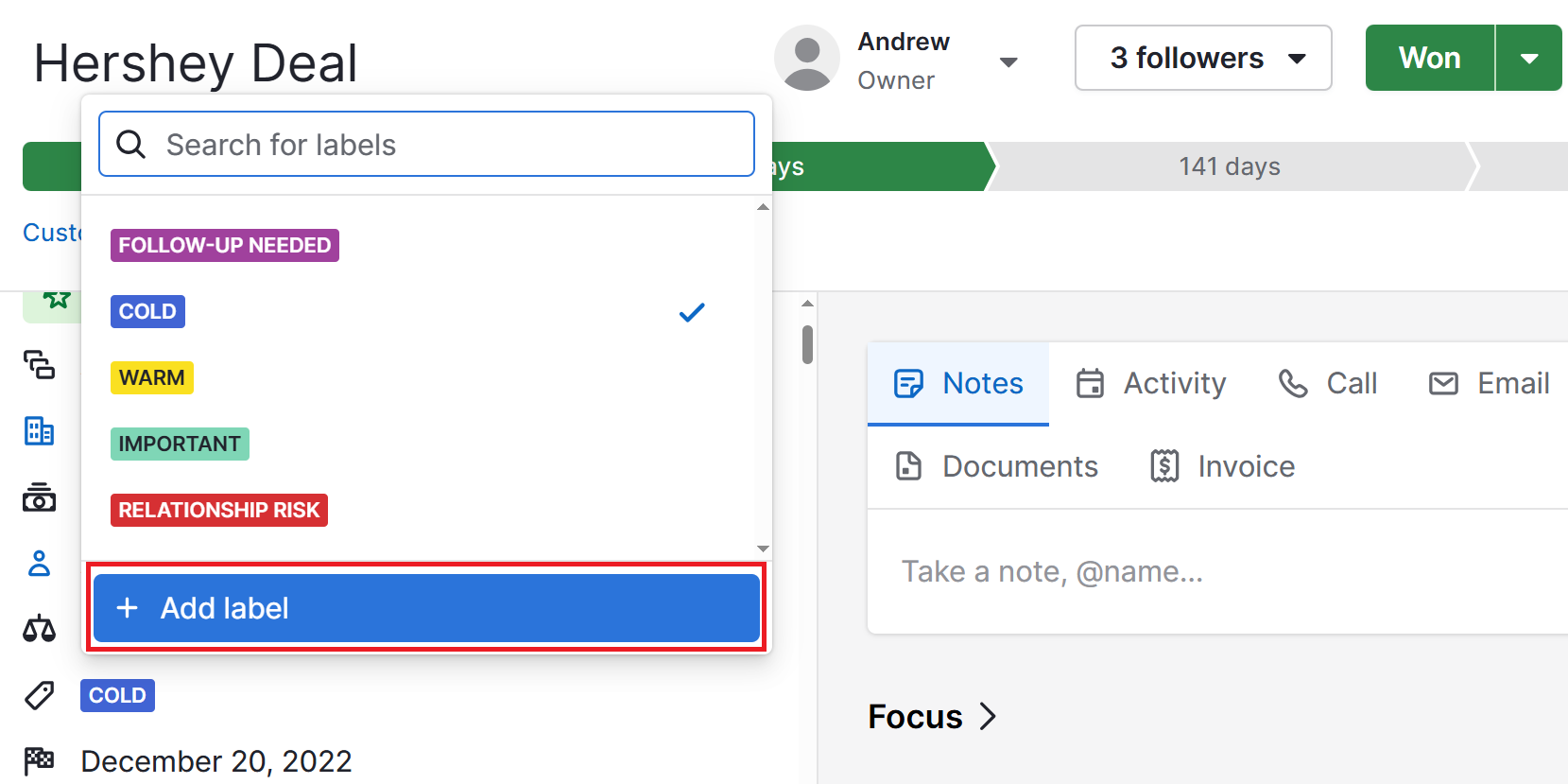
To spot interpersonal conflict in your team, create safe spaces where people feel comfortable giving feedback to managers and each other.
Make it clear that employee feedback builds stronger personal relationships and prevents bigger conflicts that impact everyone’s well-being.
2. Set clear expectations from the start
Workplace and customer conflicts usually surface because people have different ideas about what was supposed to happen.
When you spell out exactly what everyone can expect, you remove the guesswork that leads to disappointment. Make sure to document:
Project deliverables with quality standards and deadlines
Communication preferences and response timeframes
Change request processes and approval requirements
Team member roles and decision-making authority
Payment terms and late fee policies
Use Pipedrive’s Projects to create a central database for each customer where you store important documents and notes.
Log activities like phone calls and emails, or set tasks with assignees and due dates.
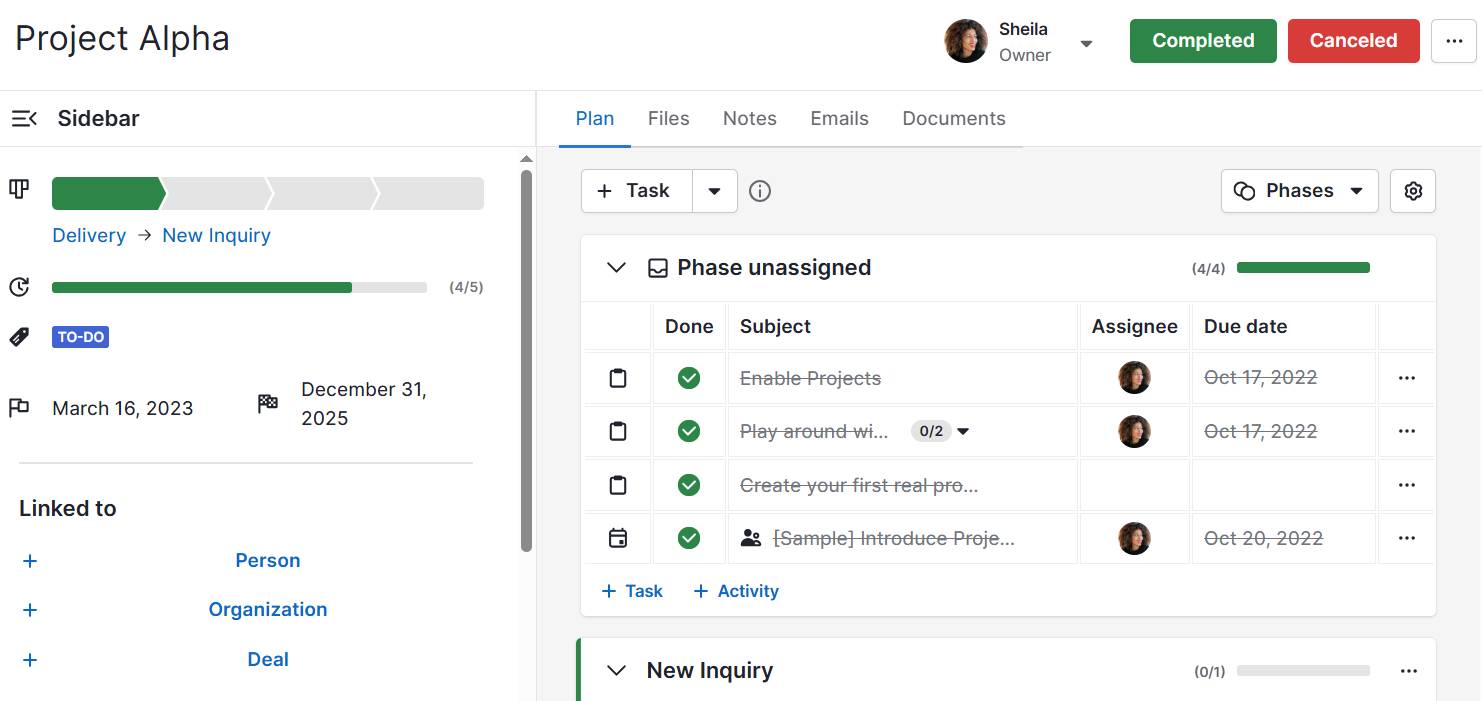
Documented expectations give you a shared reference point to return to whenever questions or disagreements arise.
Pipedrive in action: Mobility service provider Blulinc uses Projects to set checkpoints and spot potential issues early. By adding documented processes and automation, the project management team has freed up 30% of their time.
As founder Cihan Kandra explains, “In Pipedrive we have a tool that enables us to be hands-on if there are any issues. We don’t have delays and everyone has all the data when they need it.”
3. Build feedback and training into your business processes
Sometimes, workplace conflicts escalate because people don’t know how to address problems. Or, they lack the communication skills to resolve disputes constructively.
Systematic feedback and employee training fix both issues. Here’s how to integrate these activities into daily operations:
Weekly team retrospectives that identify stress points before they cause interpersonal conflict
Quarterly satisfaction surveys about customer service
Post-conflict reviews to update processes and prevent similar future issues
Regular training sessions with human resources that improve self-awareness
Team building activities to work on problem-solving skills and teamwork
Use Pipedrive’s automations to stay consistent with these conflict management strategies.
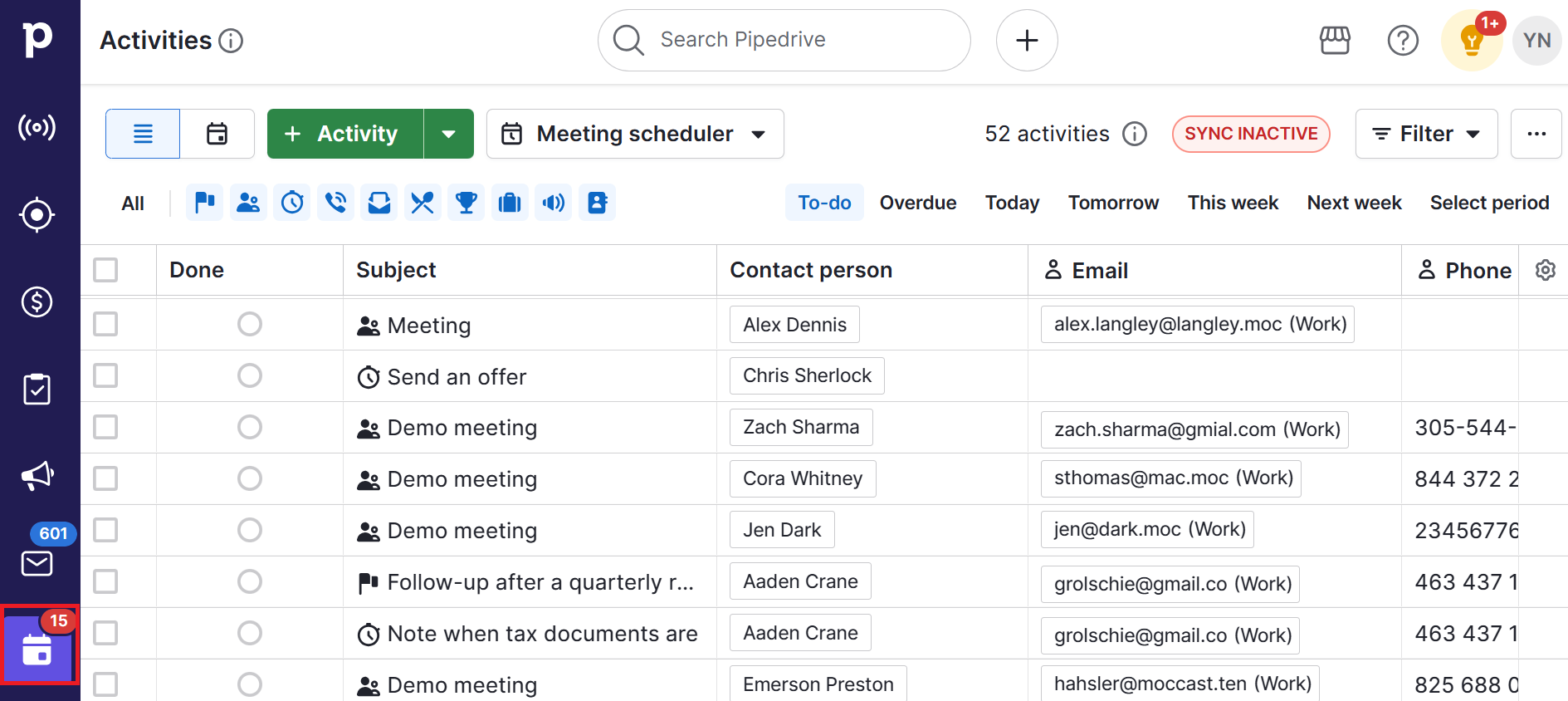
Set up automatic activities for customer check-ins or team retrospectives so everyone knows what’s coming up, keeping your team proactive and your corporate culture strong.
Final thoughts
Conflict resolution techniques turn potential disasters into stronger client and team relationships.
By integrating conflict-resolving skills into daily workflows, you can mitigate disagreements while nurturing healthy customer connections and fostering a positive team and company culture.
Try Pipedrive free for 14 days to monitor warning signs, organize your processes and strengthen your team’s ability to stop conflict in its tracks.





